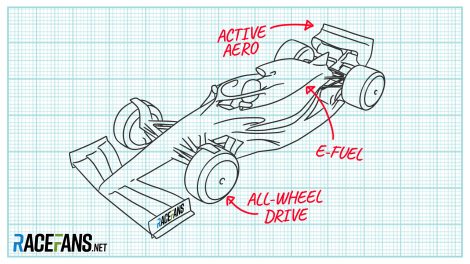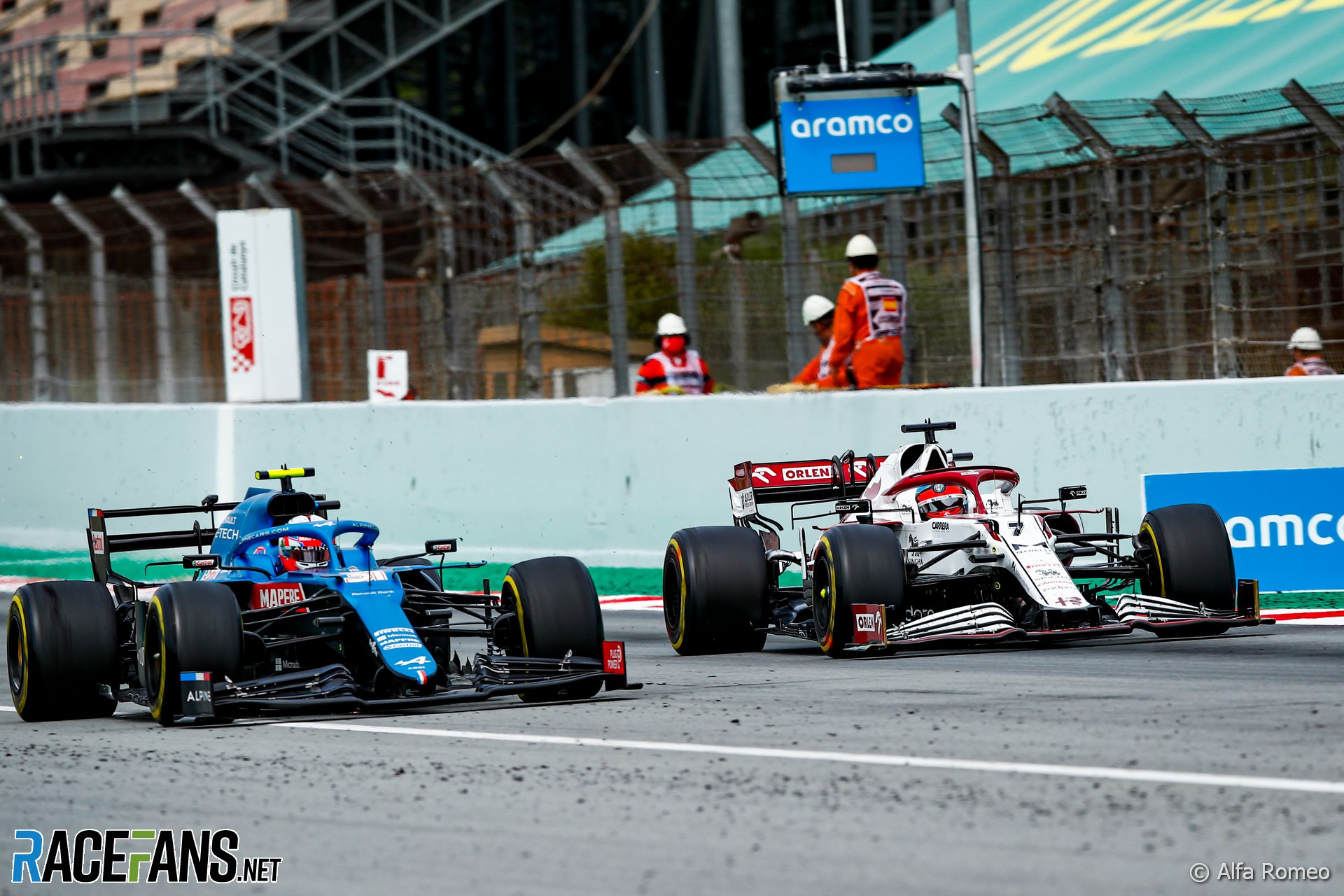Formula 1’s next set of engine regulations could arrive alongside a significant change in the chassis rules which would result in cars with much less drag.
Red Bull team principal Christian Horner said the concept was discussed at a meeting during the Austrian Grand Prix weekend to discuss F1’s future engine rules. The team will begin moving into power unit production and manufacturing next year with the creation of Red Bull Powertrains to handle its ex-Honda power units.Horner stressed the top priority for the next engine formula, currently due to arrive in 2025, is making them cheaper than the current V6 hybrid turbos, introduced in 2014.
“There’s a few scenarios to look at but the most important factor was to focus on the costs,” he said. “The cost of production, the cost of the materials of the engine to reduce the enormous burden that there is currently on the manufacturers and indeed, any engine manufacturer contemplating coming into Formula 1.
“The first thing that was missed with the current engine, the one thing that was never discussed, was what is that cost? Which is sensitive to all of those stakeholders. So I think that that is effective.
“Can that be done with the current engine, with the current architecture? Does it necessitate a new engine, does that need a new architecture and what does that look like? So there’s working groups that are going through that process at the moment. The target is still ’25, is ’26, however, more realistic.”

“What you can’t ignore is its integration with the chassis. This is assuming the chassis has a low-drag characteristics so effectively DRS won’t exist, they will be incredibly efficient cars on the straights.
“What will the tow effect be, how will that affect racing? What will be the recovery rate, potentially, with a bigger battery cell and so on. So there’s many [variables] that need to be fully looked at, but also the bigger picture of what is the right direction for Formula 1.
“I think there are elements of alignment that is close and I think there’s other differing views that will get thrashed out over the coming weeks.”
Advert | Become a RaceFans supporter and
2021 British Grand Prix
- Who was to blame for Verstappen and Hamilton’s collision at Silverstone?
- Hamilton penalty “harsh” for move within FIA’s overtaking guidance – Allison
- Why Hamilton “wasn’t seen as wholly to blame” for the Verstappen crash
- Sainz convinced he had pace to challenge for podium without British GP setbacks
- F1 will “definitely” consider more points for future sprint qualifying races





Jere (@jerejj)
16th July 2021, 17:35
DRS supposedly will be gone by 2025, depending on how well the next car concept succeeds in the intended target.
OOliver
16th July 2021, 17:41
All wheel drive I hear. Will that not add to the cost. Is F1 chasing the bird in the bush and letting go of the one in hand.
Mark Zastrow (@markzastrow)
16th July 2021, 18:16
In principle, the cost shouldn’t matter can’t spend more than the cap anyway. It’ll be up to the teams to do the best job they can with the budget they’re allowed to spend.
Theoddkiwi (@theoddkiwi)
17th July 2021, 4:15
I would expect 4wd designs to use an electric motor for the front independent from the rear wheels. This how all the 4wd EVs work. Therefore no transmission from front to rear is needed saving weight and complexity.
Rhys Lloyd (@justrhysism)
21st July 2021, 4:39
@theoddkiwi not to mention road-relevancy. F1 engineers turned to making electric motors smaller, lighter and more efficient has tangible benefits for manufacturers.
David
16th July 2021, 17:44
1. I really think now is the wrong time to commit to a new engine architecture. The future of powered transport is up in the air right now, if F1 makes the wrong call they will commit to a powertrain that may have no relevance to manufacturers.
2. Madness to have another major change in chassis architecture after only three years in a cost controlled environment. Surely a team would want a degree of stability for say, 6+ years from 2022 to even consider an entry?
F1 will almost certainly have to become an electric formula. Or a simplified hybrid with a pre-charged battery and less fuel in the tanks. Hydrogen and alternative fuels just aren’t on the agenda of the manufacturers. And let’s stick with RWD and wings for now.
JL (@j-l)
17th July 2021, 5:16
1. & 2. I agree.
But it seems that EVs are being pushed by the EU rather than by the manufacturers. There are still many unsolved issues with EVs and some of them may never go away.
Balue (@balue)
17th July 2021, 6:56
Completely
JustSomeone
17th July 2021, 15:17
You make it sound like that’s a bad thing
IVAYLO
16th July 2021, 18:16
Just let teams decide what they find relevant, let them choose their own engines.
Yaru (@yaru)
17th July 2021, 7:07
You still need to have a certain formula for the engines though, and we know that open formula doesn’t work in racing.
S
17th July 2021, 10:46
A formula, yes @yaru
A solitary specification, no.
Formula, in F1 terms, means a set of guidelines and limits – not a predetermined outcome.
Tristan (@skipgamer)
16th July 2021, 19:07
Exciting to potentially have new chassis regulations in just a few years. Less chance for decade long domination we tend to see.
Yaru (@yaru)
17th July 2021, 7:09
Mercedes only won 7 straight titles so far and probably won’t win this year, so not a decade yet?
Ben (@x-f1-x)
17th July 2021, 8:42
Only 7 straight titles? 😂👍🏻
JohnH (@johnrkh)
16th July 2021, 23:04
DRS gone by 2025 the be replaced by a heavily regulated chassis. I relatively small performance equaliser replaced by an off the shelf unchangeable interchangeable one size fits all chassis.
With Merc and Renault half way out the door, the purchase and rabid lobbying of RB now to make sense. They are aiming at becoming the other PU supplier for used to be called F1.
Yaru (@yaru)
17th July 2021, 7:11
I mean, they’re already heavily regulated now as it is. Even if most of it is, that small part that isn’t can make a huge difference in relative performance especially in race pace.
The difference between first and last now in lap times is a lot smaller than it was a fee decades ago.
cdfemke (@cdfemke)
17th July 2021, 0:57
Yessss no DRS. Finaly we will see fights on track again, instead of drivers justnwaiting on the next DRS oppertunity, cutting a ‘fight’ short for just another statistical overtake
Yaru (@yaru)
17th July 2021, 7:12
As long as the dirty air problem is mostly solved (it will never be fully solved), it should be fine to get rid of DRS. Otherwise its necessary to countersct the dirty air when you are following.
The other alternative being to get rid of aeros completely that is.
Broccoliface
17th July 2021, 7:09
DRS needs to be gone by 2023
Yaru (@yaru)
17th July 2021, 7:13
If 2022 works well with the dirty air problem, I agree.
Ben (@x-f1-x)
17th July 2021, 8:45
Good thing about ground effect is that ground effect floor will not be fussy with the air it is recieving, whether that be clean or dirty.
Jonathan Bovier
17th July 2021, 19:18
I feel like F1 will shoot its own legs away with such plans. They fail to realize that an over-optimised engine concept being the rule is not going to motivate any manufacturer to enter, even less so if they keep the current architecture. The rules as they have been enforce by design that you have to walk all the extra miles to gain minimalistic performance gains. And as any engineering student in his second semester can tell, that’s where the costs explode.
Same applies to the chassis, though the development costs aren’t as dramatic as in case of the PUs (mainly the ICU).
Argh, I just yearn for F1 to finally let the engineers figure things out again, technologically this sport became complex, yet boring.